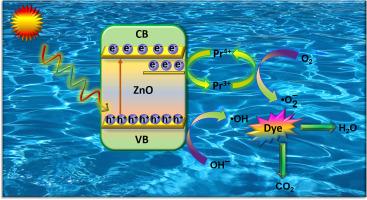Efficient photocatalytic degradation of antibiotic levofloxacin and organic pollutants in water by Pr doped ZnO nanorods
Abstract
Doping is a promising route to improve photodegradation performance of wide bandgap semiconductors and has drawn attention for the fabrication of efficient sun light driven photocatalysts. We have reported a simple wet chemical fabrication of Pr doped ZnO nanorods with strong photodegradation efficiency in the decolorization of organic pollutants such as synthetic dyes and antibiotic levofloxacin. The influence of Pr doping on the structure, lattice parameters and morphology of nanostructured ZnO were investigated via XRD, Raman spectroscopy and FESEM, while PL and UV–visible spectroscopy were employed to study the optical absorption and photocatalytic response. The results revealed that Pr+3 ions are successfully substituted in ZnO lattice and band gap of the doped ZnO photocatalysts shifted slightly to the visible region. Photocatalytic capability of ZnO nanostructures was significantly improved upon Pr doping and amongst all 0.5 % Pr doped ZnO nanorods exhibited superior photodegradation ability under sunlight illumination. The enhanced photodegradation performance is attributed to improved light utilization, high defect concentration and effective separation of photoinduced charge carriers. The degradation mechanism along with the scavenger trapping experiments has been proposed which showed that hydroxyl radicals are the dominating active species involved in the decomposition of pollutant.


 求助内容:
求助内容: 应助结果提醒方式:
应助结果提醒方式:


